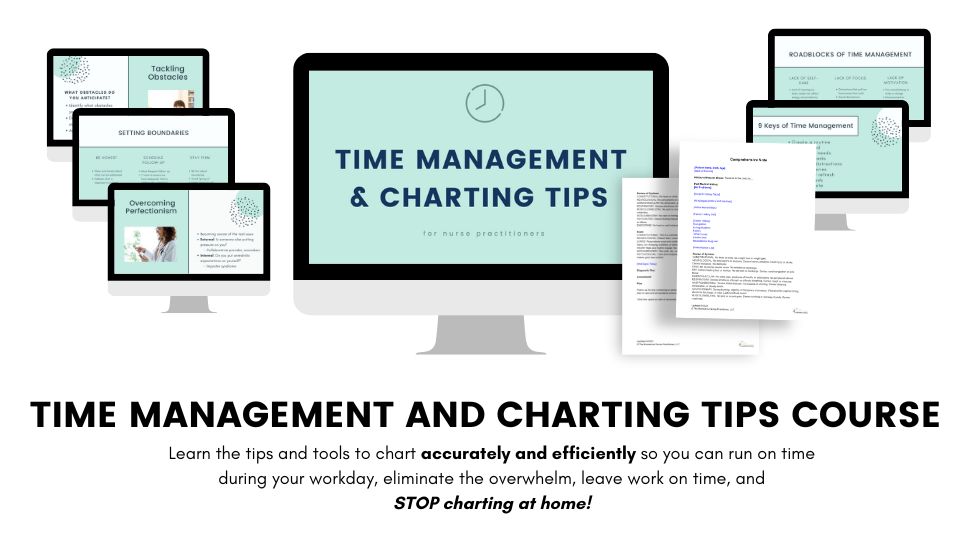Hospitalists nurse practitioners face several barriers to effective time management that can impact their ability to get those notes signed! Hospitalists have a demanding job, requiring them to manage multiple patients, work in a fast-paced environment, and coordinate care with other healthcare providers.
The hospital setting has different challenges than an outpatient setting. Which means the approach to time management for hospitalist nurse practitioners differs from a clinic setting. This article will focus on these differences with specific tips of time management for hospitalist nurse practitioners.
Barriers hospitalist nurse practitioners experience
Here are some common barriers that hospitalists may encounter:
- Workload in the hospital setting. Hospitalists often have a heavy workload, with multiple patients and competing demands. Hospitalist nurse practitioners are busy with admitting new patients, rounding on inpatients, and discharging patients. This can make it challenging to prioritize tasks and manage time effectively.
- Current tasks. Hospitalists often have to complete a variety of tasks, such as ordering and reviewing diagnostic tests, ordering medications, rounding on patients, updating patient’s family members, coordinating care with nurses and specialty providers, documentation, and billing. Needless to say, time management for hospitalist nurse practitioners can be challenging!
- Interruptions. Hospitalists may be interrupted frequently, with phone calls, pagers, and requests from other healthcare providers, which can disrupt their workflow and take longer to complete tasks.
- Inefficient processes. Inefficient processes, such as outdated technology or lack of communication among healthcare providers, can slow down hospitalists’ workflow and make it challenging to manage time effectively. While electronic health records (EHR) were created to streamline the documentation process, EHRs seem to create more/duplicate work for hospitalist nurse practitioners.
- Lack of support. Hospitalists may not have adequate support. Many hospitals are seeing record high staffing shortages. This creates challenges to the workflow of a hospital unit and can delay efficient care for patients. These staffing shortages can increase hospitalist nurse practitioners workload and make it challenging to manage time effectively.
- Nurse practitioner burnout. When a hospitalist nurse practitioner struggles with burnout, it can impact their ability to manage time effectively by reducing their productivity. Nurse practitioner burnout can cause mental, physical, emotional exhaustion. The workload, decision making, and frequent interruptions can cause increased mental fatigue and stress for burned-out nurse practitioners. Many nurse practitioners struggle with completing tasks and leaving work on time. This can create a lack of work-life balance which worsens nurse practitioner burnout.
As you can see, there are many challenges hospitalist nurse practitioners experience. These obstacles make it difficult to stay on track and get those charts signed! When the work does not get completed during the day, many APRNs have to stay late or bring charts home disrupting work-life balance.
Strategies to Overcome Barriers to Time Management
Below are a 10 strategies to move past these challenges hospitalist nurse practitioners experience. For more tips, check out The Time Management and Charting Tips Course.
Create a routine.
If there is one thing certain in healthcare it is that nothing goes as planned. As a hospitalist nurse practitioner, you may have a decent list of patients to round on only to get bombarded with 6 admissions back to back.
There is so much variability in the hospital setting it can be difficult to feel in control of the day. However, if the hospitalist nurse practitioner can create a flexible routine, it will help them better manage their time.
Here is an example of a routine:
7:40- arrive to work and get settled
7:45- review patients, anticipate, address critical labs
8:15 to 9:30- round on critical patients
9:30 to 11:30- round on discharges, documenting after seeing each patient
11:30 to 12:15- address urgent needs
12:15 to 12:45- Lunch break: allow time to fuel/rest
12:45- review patient charts
13:00 to 15:00- round on patients
15:00- address messages/phone calls
15:15 to 17:00- finish documentation and prepare for next day
17:00 leave the office on time without bringing charts home!
This is just an example of a routine for a hospitalist nurse practitioner. Take some time and create a routine based on specific work hours and obligations throughout the day. But creating a routine helps hospitalist nurse practitioners increase focus and eliminate the questioning of what task they should do next.
Anticipate needs.
Anticipating needs of patients or hospital staff can help you save a lot of time as a hospitalist nurse practitioner. If you can take some time at the start of the day to do a quick overview of patients it can save you a lot of time throughout the day. Review patient charts and anticipate any needs that may come up throughout the day.
For example, ensuring lab orders are placed in the electronic medical record allows the lab to draw serum and process the lab BEFORE you round on the patient. Calling cardiology and discussing the plan of care of a patient helps so you can spend your time discharging the patient rather than waiting around to see what cardiology recommends.
Anticipating the needs of a patient saves a lot of time for the hospitalist nurse practitioner.
Minimize interruptions.
Avoiding distractions and interruptions can be challenging for a hospitalist nurse practitioner. But creating increased focus will help you accomplish tasks in less time.
Minimize interruptions by setting boundaries with staff. If you are constantly getting phone calls from a certain acute care floor, give them a heads up you you will be rounding on that floor in one hour. Encourage staff to wait to ask questions until you are rounding on that patient.
Find a quiet area to document patient encounters. Insert noise canceling headphones so you can better concentrate. Turn your phone on silent and close out email on computer. This allows hospitalist nurse practitioners to better focus on the task at hand.
Create comprehensive admission notes.
If the hospitalist nurse practitioner is admitting patient and later rounding on the same patient, it saves time to create a comprehensive admission note. Same thing is true if the APRN is able to round on the same patient for multiple days in a row.
The hospitalist nurse practitioner can then “copy and paste” information into the current progress note. This saves a ton of time from having to re type or dictate the information. Just be sure to make any changes of updated diagnoses, orders, and/or exam!
Utilize smart phrases.
Smart phrases are a prepopulated phrase or group of text that the nurse practitioner constantly documents. For example, its likely the hospitalist nurse practitioner addresses DVT prophylaxis for all patients. Therefore, create a smart or dot phrase to easily pull into the current chart note. This can save a TON of time for hospitalist nurse practitioners!
**Check out The Nurse Practitioner Charting School’s Comprehensive List of Smart Phrases! There are ready to use smart phrases specifically for hospitalist nurse practitioners! Click here for more information!
Streamline processes.
Streamline processes by identifying inefficiencies and implementing changes to improve workflow. I encourage hospitalist nurse practitioners to become aware of the current workflow and process in the hospital setting. Complete a time log for a typical work day and reflect on any process that may need to be changed.
Talk to your colleagues and manager about making the workflow changes. It’s very likely that they may benefit from the process change as well! I always encourage nurse practitioners to advocate for what they need at their workplace!
Practice delegation.
Delegate tasks to other healthcare providers, such as nurses and support staff, to free up your time and allow you to focus on critical patient care needs.
I know as an APRN you are more than capable of helping a patient to the bathroom or grabbing a warm blanket. But as hospitalist nurse practitioners, the main tasks include rounding on patients and documenting the patient encounter. Nurse practitioners should focus on these most important tasks and work on delegating the other tasks.
Take breaks.
As counter intuitive as it sounds, taking a break from the stress and overwhelm of the job can actually improve productivity. When we give our minds time to rest and recharge, we can focus better and complete the task at hand.
Take regular breaks throughout the day to recharge and prevent nurse practitioner burnout. This can include short breaks to stretch or take a walk, or longer breaks to eat lunch or decompress. Even as you walk from one side of the hospital to another, make it a point to disconnect from your phone and let your mind rest.
Communicate effectively.
Communicate effectively with other healthcare providers to ensure that everyone is on the same page. Use handoff tools and communication boards to facilitate clear communication. Ensure orders are placed in a timely manner and that all questions from nurses, case managers, etc. are answered.
If the nurse practitioner can communicate effectively while rounding on the patient, it will decrease phone calls and questions later.
Seek support.
If you are a hospitalist nurse practitioner struggling with burnout, you are not alone! Reach out to colleagues and support staff about what you are experiencing. Join The Burned-out Nurse Practitioner Facebook Group for understanding from equally burned-out nurse practitioners. You do not have to go through this burnout alone!
In conclusion, hospitalists face several barriers to effective time management. But hospitalist nurse practitioners can overcome these barriers and improve their ability to provide quality patient care.
To learn more time management and charting tips, check out The Nurse Practitioner Charting School’s blog page. Visit The Comprehensive List of Smart Phrases. Also check out The Time Management and Charting Tips Course for additional help!

Erica D the NP is a family nurse practitioner and The Nurse Practitioner Charting Coach. Erica helps nurse practitioners STOP charting at home! Erica created The Nurse Practitioner Charting School to be the one stop for all documentation resources created specifically for nurse practitioners. Learn more at www.npchartingschool.com
Follow on Facebook: The Nurse Practitioner Charting SchoolAnd on Instagram: @npchartingschool
Free training: 4 charting tips to help nurse practitioners get their time back! Sign up here!




